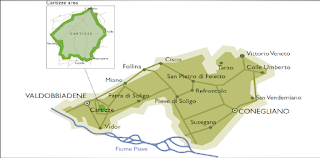What is Prosecco? Is it a region, a wine, or a grape variety? Before 2009 this term described all three; but in that year several reforms were implemented to clarify the definition. First, the Prosecco DOC was created which covers a vast area spanning two regions (Friuli Venezia Giulia & Veneto), nine provinces, and 556 townships. It is geographically located north of Venice in parts of Veneto and Friuli. At the same time the historical birthplace of Prosecco, Conegliano Valdobbiadene, was granted DOCG status. This is a region of steep hillsides located between the villages of Conegliano and Valdobbiadene. And finally, the name of the primary grape variety used in making Prosecco wine was changed from Prosecco to Glera - a historical synonym.
The word Prosecco is most likely Slovenian in origin "derived from prosek, a dialectic term for 'path cut through the woods'". In Croatia a sweet passito wine called Prošek has been produced for thousands of years - although the EU has now banned that usage. In Italy Prosecco evolved from the name of a village near Trieste to its wider use. The first known mention of Prosecco in Italy occurred in 1593 when an English traveler named Fynes Moryson wrote "[In] Histria (Trieste) proper grows the wine Pucinum, now called Prosecho, much celebrated by Pliny". Pucinum refers an ancient wine drunk by the Romans.
The modern history of Prosecco began in 1876 when enologist Giovanni Battista Cerletti founded the Scuola Enologico in Conegliano. The wine's popularity accelerated with improved secondary fermentation techniques starting with Federico Martinotti patented method using large pressurized temperature-controlled receptacles. Eugène Charmat's adoption of the autoclave in secondary fermentation soon followed. Post WWII this autoclave became "widely adopted throughout the area of Conegliano Valdobbiadene and the modern sparkling wine industry was born". Over time this historical region lost focus as more producers outside the region began producing Prosecco sparkling wine. Thus the 2009 reforms.
Whereas the larger Prosecco DOC incorporates four provinces of Friuli Venezia Giulia (Gorizia, Pordenone, Trieste and Udine) and five provinces of Veneto (Belluno, Padua, Treviso, Venice, Vicenza), the Conegliano Valdobbiadene Prosecco DOCG comprises 15 hillside towns with thousands of small growers supplying 183 wineries.
There are three styles of wine in both the DOC & DOCG: Spumante (95% of production), Frizzante, and Tranquillo (Still). And there are three categories of residual sugar: Dry (17-32 grams of residual sugar), Extra-Dry (12-17 grams), and Brut (0-12 grams). A fourth category, Extra Brut, was just adopted and will incorporate wines from 0-6 grams.
Other requirements include that the grapes in a Prosecco wine must be at least 85% Glera with the remaining 15% from other authorized grape varieties. Secondary fermentation can be achieved via the autoclave method or in the bottle ("Rifermentato in Bottiglia"). And finally labeling. Superiore refers to only Spumante wines made within the ConVal DOCG. Millesimato indicates a wine made from a single vintage (85% minimum). And Rive indicates a Prosecco Superiore made entirely of grapes from one of the designated Rive (villages).
Bervini 1955 is one Prosecco DOC brand founded by Antonio Bergamo and his son Giuseppe in, you guessed it, 1955; and today is operated by Giuseppe and his son Paolo.The winery is located in the Pordenone province of northeast Friuli Venezia Giulia and actually resides in both the Prosecco DOC and the Friuli Grave DOC - noted for wines made from Chardonnay, Sauvignon Blanc, Pinot Grigio and Friulano. I received two of their Prosecco offerings starting with the
2016 Spumante Prosecco D.O.C. Millesimato Extra Dry ($18.99). The Millesimato designates that the wine is comprised of 100% Glera -- sourced from vineyards in both Veneto and Friuli Venezia Giulia. This is a lively wine, loads of citrus, effervescence, and completely enjoyable. The
Spumante NV Rosé Extra Dry ($18.99) is sourced from Raboso and Cabernet grapes from Friuli Venezia Giulia and because of the absence of Glera is not labeled Prosecco. Nevertheless it is a clean wine, bursting with berry flavors but noticeably dry.... This one goes fast.
I also recently received three Conegliano Valdobbiadene Prosecco DOCG samples that are further refined.
The
Masottina Conegliano Valdobbiadene Prosecco DOCG Superiore Millesimato Brut ($22) is produced from another third generation family, this one in the Conegliano area. The wine is an elegant display of 100% Glera with apple and citrus notes, soft an creamy, and lively acids.
The
Villa Sandi Valdobbiadene Prosecco Superiore DOCG Extra Dry ($23) possesses both weight and freshness balanced again between apples and citrus. The finish persists long after the bubbles have dissipated.
Finally, the
Bianca Vigna Conegliano Valdobbiadene Prosecco DOCG Superiore Millesimato Brut ($24) is fantastic, both creamy and saline with more stone fruit than citrus.











